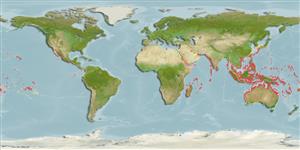Common names from other countries
Classification / Names / Names
Populärnamn | synonymer | Catalog of Fishes (gen., sp.) | ITIS | CoL | WoRMS
Environment: milieu / climate zone / depth range / distribution range
Ekologi
; djupintervall 0 - 81 m (Ref. 104607), usually 0 - 20 m (Ref. 75831). Tropical
Indo-Pacific: from East Africa, to eastern Polynesia; north to southern Japan and south to Queensland.
Length at first maturity / Size / Vikt / Age
Maturity: Lm ? range ? - ? cm Max length : 4.0 cm SHH hane/ej könsbestämd; (Ref. 348); common length : 3.0 cm SHH hane/ej könsbestämd; (Ref. 348)
Commonly collected in many areas, mainly for decorative purposes. Found in intertidal (Ref. 75831), littoral and sublittoral areas with open coral reef and sandy mixed, and seagrass bottoms (Ref. 104607).
Life cycle and mating behavior
Könsmognad | Reproduktion | Lek | Ägg | Fecundity | Larver
Members of the class Bivalvia are mostly gonochoric, some are protandric hermaphrodites. Life cycle: Embryos develop into free-swimming trocophore larvae, succeeded by the bivalve veliger, resembling a miniature clam.
Poutiers, J.M. 1998. (Ref. 348)
IUCN Red List Status (Ref. 130435)
CITES status (Ref. 108899)
Not Evaluated
Not Evaluated
Threat to humans
Harmless
Human uses
| FishSource |
Verktyg
Ytterligare information
Age/Size
Tillväxt
Length-weight
Length-length
Morfologi
Larver
Abundans
Internet-källor
Estimates based on models
Preferred temperature
(Ref.
115969): 24.4 - 29, mean 28 (based on 1118 cells).
Vulnerability
Low vulnerability (10 of 100).
